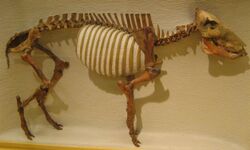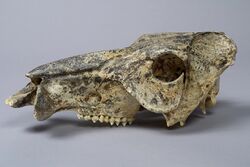Biology:Platygonus
| Platygonus | |
|---|---|

| |
| Platygonus compressus skeleton at Harvard University | |
| Scientific classification | |
| Domain: | Eukaryota |
| Kingdom: | Animalia |
| Phylum: | Chordata |
| Class: | Mammalia |
| Order: | Artiodactyla |
| Family: | Tayassuidae |
| Genus: | †Platygonus LeConte 1848 |
| Type species | |
| †Platygonus compressus LeConte 1848
| |
| Species | |
|
See text | |
| Synonyms | |
| |
Platygonus ("flat head" in reference to the straight shape of the forehead)[1] is an extinct genus of herbivorous peccaries of the family Tayassuidae, endemic to North and South America from the Miocene through Pleistocene epochs (10.3 million to 11,000 years ago), existing for about 10.289 million years.[2] P. compressus stood 2.5 feet (0.76 meters) tall.[3][4]

Description
Most Platygonus species were similar in size to modern peccaries especially giant peccary, at around 1 m (3.3 ft) in body length, and had long legs, allowing them to run well. They also had a pig-like snout and long tusks which were probably used to fend off predators.[5]
Taxonomy
While long thought to be the sister-lineage to the Chacoan peccary based on morphological similarities, a 2017 ancient DNA study which recovered mitochondrial DNA from Platygonus found that all living peccaries are more closely related to each other than they are to Platygonus. The estimated divergence between Platygonus and all living peccaries was placed in the Miocene, around 22 million years ago.[6]
Ecology
Like modern peccaries, Platygonus is thought to have lived in herds. Their remains are particularly abundant in caves, suggesting that they regularly used them. A study on the population structure of a population of P. compressus from Bat Cave, Missouri found that they had a similar demographic structure to modern peccaries, dominated by young adults, with a progressive attenuation of older adults due to predation and old-age, up to a maximum age of around 10 years.[7] Platygonus is though to have consumed tough foliage like leaves and grass.[8]
Distribution
During the Late Pleistocene, Platygonus was most common in Eastern North America, with records in the Great Plains and western North America being more sparse.[9] In South America, Platygonus ranged from Colombia to Argentina.[10]
Taxonomy

Platygonus was named by John Lawrence LeConte in 1848 for fossils found in Pleistocene karst deposits in Illinois, which are now preserved in the Academy of National Sciences in Philadelphia.
The following species of Platygonus have been described:[2]
- P. bicalcaratus (nomen dubium)
- P. brachirostris
- P. chapadmalensis
- P. cinctus
- P. compressus (type)
- P. kraglievichi
- P. marplatensis
- P. narinoensis
- P. oregonensis
- P. pearcei
- P. pollenae
- P. scagliae
- P. setiger
- P. striatus
- P. texanus
- P. vetus
Fossil localities
Fossils of Platygonus have been found in:[2]
- Miocene
- Sheep Creek Formation, Nebraska
- Chapadmalalan
- Chapadmalal Formation, Argentina
- Hemphillian
- Beecher Island, Colorado
- Edson Beds, Kansas
- Rancho Viejo Beds, Mexico
- Devil's Nest Airstrip, Ogallala Group, Nebraska
- McKay and Rattlesnake Formations, Oregon
- Miami Quarry, Texas
- Blancan
- Gila Conglomerate and St. David Formation, Arizona
- Palm Spring and San Diego Formations, California
- Tamiami Formation, Florida
- Glenns Ferry Formations, Idaho
- Ballard, Rexroad and Crooked Creek Formations, Kansas
- Rancho Viejo Beds, Mexico
- Tequixquiac, Mexico
- Panaca Formation, Nevada
- Camp Rice Formation, New Mexico
- Blanco and Love Formations, Texas
- Ringold Formation, Washington (state)
- Plio-Pleistocene
- Cocha Verde, Taminango, Colombia[11]
- Pleistocene
- Tarija Formation, Bolivia
- Palm Spring and Turlock Lake Formations, California
- Bermont and Wicomico Formations, Florida
- Yarbrough Cave, Georgia
- American Falls Lake Bed E Formation, Idaho
- Galena, Illinois (type locality)[12]
- Harrodsburg Crevice, Indiana
- Turin Pit, Iowa
- Kingsdown and Crooked Creek Formations, Kansas
- Welch Cave, Kentucky
- Cumberland Bone Cave and Bushey Cavern, Maryland
- Tacubaya Formation, Mexico
- Geddes Lake barrow pit, Michigan
- Little Beaver Cave, Jacob's Cave, and Zoo Cave, Missouri
- Sappa Formation, Nebraska
- Dry Cave, New Mexico
- Sheriden Cave, Ohio
- Holloman Gravel Pit, Oklahoma
- Fossil Lake, Oregon
- Hanover Quarry and Platygonus vetus type locality, Pennsylvania
- Hot Springs Mammoth Site, South Dakota
- Laubach Cave, Seymour, Tule and Shuler Formations, Texas
- Early's Cave, Gardner's Cave, New Quarry Cave, Vickers Cave, Ruffners Cave, Virginia
- Hamilton Cave, Trout Cave, Poorfarm Cave, Patton Cave, West Virginia
- Wellsch Valley, Saskatchewan
- Old Crow Flats, Yukon[13]
References
- ↑ "Peccary". Idaho Museum of Natural History. November 2002. http://imnh.isu.edu/digitalatlas/geog/parks/hagerman/text/peccany.htm.
- ↑ 2.0 2.1 2.2 Platygonus in the Paleobiology Database
- ↑ Perry, Tahlia; van Loenen, Ayla L.; Heiniger, Holly; Lee, Carol; Gongora, Jaime; Cooper, Alan; Mitchell, Kieren J. (July 2017). "Ancient DNA analysis of the extinct North American flat-headed peccary (Platygonus compressus)". Molecular Phylogenetics and Evolution 112: 258–267. doi:10.1016/j.ympev.2017.03.024. ISSN 1095-9513. PMID 28363818.
- ↑ "Flat-headed Peccary | Explore the Ice Age Midwest". http://iceage.museum.state.il.us/mammals/flat-headed-peccary-0.
- ↑ Palmer 1999, p. 269
- ↑ Perry, Tahlia; van Loenen, Ayla L.; Heiniger, Holly; Lee, Carol; Gongora, Jaime; Cooper, Alan; Mitchell, Kieren J. (July 2017). "Ancient DNA analysis of the extinct North American flat-headed peccary (Platygonus compressus)" (in en). Molecular Phylogenetics and Evolution 112: 258–267. doi:10.1016/j.ympev.2017.03.024. PMID 28363818.
- ↑ Woodruff, Aaron L.; Schubert, Blaine W. (2019-07-04). "Seasonal denning behavior and population dynamics of the late Pleistocene peccary Platygonus compressus (Artiodactyla: Tayassuidae) from Bat Cave, Missouri" (in en). PeerJ 7: e7161. doi:10.7717/peerj.7161. ISSN 2167-8359. PMID 31308997.
- ↑ Bradham, Jennifer L.; DeSantis, Larisa R.G.; Jorge, Maria Luisa S.P.; Keuroghlian, Alexine (June 2018). "Dietary variability of extinct tayassuids and modern white-lipped peccaries (Tayassu pecari ) as inferred from dental microwear and stable isotope analysis" (in en). Palaeogeography, Palaeoclimatology, Palaeoecology 499: 93–101. doi:10.1016/j.palaeo.2018.03.020. Bibcode: 2018PPP...499...93B. https://linkinghub.elsevier.com/retrieve/pii/S0031018217309392.
- ↑ Wilson, Kurt M.; Hill, Matthew G. (November 2020). "Synthesis and assessment of the flat-headed peccary record in North America" (in en). Quaternary Science Reviews 248: 106601. doi:10.1016/j.quascirev.2020.106601. https://linkinghub.elsevier.com/retrieve/pii/S0277379120305631.
- ↑ Gasparini, Germán M.; Moreno-Mancilla, Oscar F.; Cómbita, José L. (2021-03-29). "Selenogonus narinoensis Stirton, 1947 (Tayassuidae, Cetartiodactyla, Mammalia): taxonomic status and paleobiogeographic implications" (in en). Fossil Record 24 (1): 65–75. doi:10.5194/fr-24-65-2021. ISSN 2193-0074. https://fr.copernicus.org/articles/24/65/2021/.
- ↑ Cocha Verde at Fossilworks.org
- ↑ Galena at Fossilworks.org
- ↑ [1] at ResearchGate.org
Bibliography
- Fiedal, Stuart (2009). "Sudden Deaths: The Chronology of Terminal Pleistocene Megafaunal Extinction". in Haynes, Gary. American Megafaunal Extinctions at the End of the Pleistocene. Vertebrate Paleobiology and Paleoanthropology. Springer. pp. 21–37. doi:10.1007/978-1-4020-8793-6_2. ISBN 978-1-4020-8792-9.
- Palmer, D., ed (1999). The Marshall Illustrated Encyclopedia of Dinosaurs and Prehistoric Animals. London: Marshall Editions. ISBN 978-1-84028-152-1.
Further reading
- Mendoza, M.; Janis, C. M.; Palmqvist, P. (2006). "Estimating the body mass of extinct ungulates: a study on the use of multiple regression". Journal of Zoology 270 (1): 90–101. doi:10.1111/j.1469-7998.2006.00094.x. http://webpersonal.uma.es/de/ppb/JZool.pdf. Retrieved 1 July 2013.
Wikidata ☰ Q1051024 entry
 |
